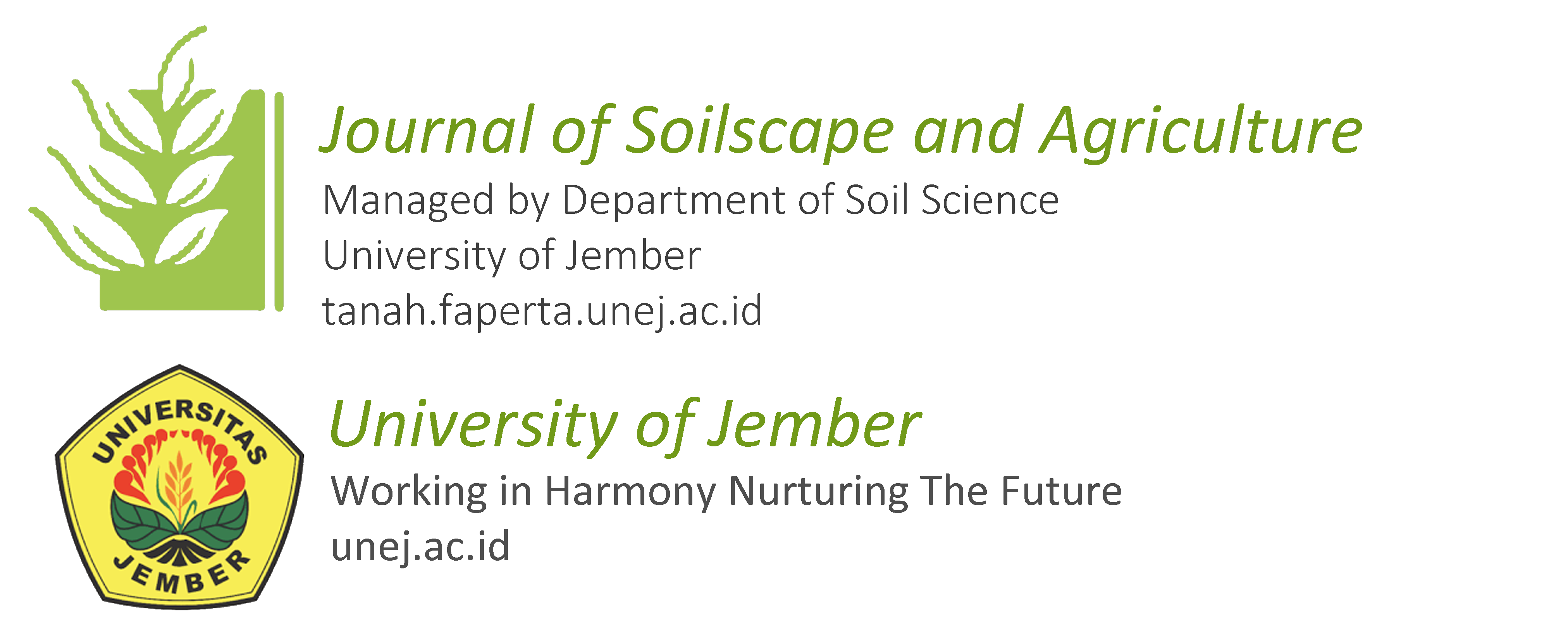The Effectiveness Test of Biofertilizer Phosphate-Solubilizing Bacteria (PSB) and Phosphate Fertilizer on The P availability in the Soil and Tomato Plant Tissue
DOI:
https://doi.org/10.19184/jsa.v3i1.1528Keywords:
Phosphate-Solubilizing, Biofertilizer, TomatoAbstract
Phosphorus is one of the essential nutrients whose availability is very small in the soil. Research on the effectiveness test of biofertilizer phosphate solubilizing bacteria (PSB) and phosphate fertilizer (SP-36 and rock phosphate) on the availability of soil p and p content in tomato plant tissue to determine the effectiveness of SP-36, Rock Phosphate and PSB in increasing P availability soil. The study used factorial randomized block design with two factors and three replications. The first factor is a phosphate solvent bacterial isolate consisting of two levels, without isolate Pseudomonas sp. and with Pseudomonas sp. The second factor is phosphate fertilizer with five levels of control; SP-36 fertilizer 0.32 g/plant; SP-36 fertilizer 0.63 g/plant; rock phosphate fertilizer 0.41 g/plant; and rock phosphate fertilizer 0.81 g/plant. The data obtained were analyzed using Analysis of Variety and continued with Duncan Multiple Range Test (DMRT) test with 95% confidence level. The results showed that the administration of PSB isolate gave increased P-available, P tissue, plant height, wet weight and dry weight of plant and tomato plant production. The application of SP-36 and rock phosphate fertilizer gave an increase to P-available and P-tissue variables, whereas for the production of SP-36 fertilizer plants with dose of 65 g/plant gave higher yield compared to rock phosphate fertilizer.
References
Ginting, R. (2007). Mikroorganisme Pelarut Fosfat. Jakarta : Aneka Aksara.
Havlin, J.L., S. L. Tisdale, W. L. Nelson, dan J.D. Beaton. (2013). Soil Fertility And Festilizers. An Introduction to Nutrient Management. Eighth ed. Prientice Hall, New Jersey.
Horneck, D.A., D.M. Sullivan, J.S. Owen, and J. M. Hart. (2011). Soil Test Interpretation Guide. Oregon State University. www.researchgate.net/publication/265097991
Iftikhar, A., n. Aijaz, R. Farooq, S. Aslam, A. Zeeshan, M. Munir, M. Irfan, T. Mehmood, M. Atif, M. Ali, and A. Shiraz. (2023). Beneficial Role of Phosphate Solubilizing Bacteria (PSB) In Enhancing Soil Fertility Through a Variety of Actions On Plants Growth and Ecological Perspective: An Updated Review. Xi’an Shiyou University, 19 :520-547. www.researchgate.net/publication/374023189
Jiang, H., P. Qi, T. Wang, M. Wang, M. Chen, N. Chen, L. Pan, and X. Chi. (2018). Isolation and characterization of halotolerant phosphate-solubilizing microorganisms from saline soils. 3 Biotech, 8(11): 461. https://doi.org/10.1007%2Fs13205-018-1485-7
Khan, A. A., G. Jilani, M. S. Akhtar, S. M. S. Naqvi and M. Rasheed. (2014). Phosphorus Solubilizing Bacteria: Occurrence, Mechanisms and their Role in Crop Production. Agic Biol Sci, 1 (1) : 48-58. DOI 10.1007/978-3-319-08216-5_2.
Oteino, N, R. D. Lally, S. Kiwanuka, A. Lloyd, D. Ryan, K. J. Germaine, and D. N. Dowling. Plant growth promotion induced by phosphate solubilizing endophytic Pseudomonas isolates. (2015). Front. Microbiol. 6 (745): 1-9. http://dx.doi.org/10.3389/fmicb.2015.00745
Sabrina, S. Q. A, Aisyah, dan A. N. Huda. (2020). Peranan Bahan Organik Pada Bakteri Pelarut P Terhadap P Tanah Tersedia Dan Pertumbuhan Tanaman Tomat (Solanum Lycopersicum). Gontor AGROTECH Science. 6(3): 199-232. http://dx.doi.org/10.21111/agrotech.v6i3.4929
Sharma, S. B., R. Z. Sayyed, M. H. Trivedi and T. A. Ghobi. (2013). Phosphate solubilizing microbes: sustainable approach for managing phosphorus deficiency in agicultural soils. SpringerPlus, 2 (587) : 1-14. http://www.springerplus.com/content/2/1/587
Suliasih, S. Widawati, dan A. Muharam. (2010). Aplikasi Pupuk Organik dan Bakteri Pelarut Fosfat untuk Meningkatkan Pertumbuhan Tanaman Tomat dan Aktivitas Mikroba Tanah. Hort, 20(3): 241-246.
Tchakounte, G. V. T., B. Berger, S. Patz, M. Becker, H. Fankem, V. D. Taffouo, and S. Ruppel. Selected Rhizosphere Bacteria Help Tomato Plants Cope with Combined Phosphorus and Salt Stresses. (2020). Microorganism, 8(11): 1-12. http://dx.doi.org/10.3390/microorganisms8111844
Downloads
Published
How to Cite
Issue
Section
License
Copyright (c) 2024 Journal of Soilscape and Agriculture

This work is licensed under a Creative Commons Attribution-NonCommercial-ShareAlike 4.0 International License.



